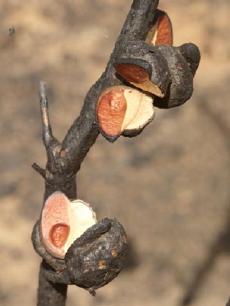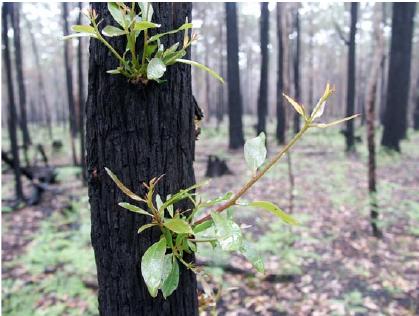Fire Ecology Program
By Gayle Osborne

Hakea fruit opening after fire (photo by Tibor Hegedis)
The Fire Ecology Program is a joint initiative of the Department of Sustainability and Environment, Parks Vic and the Country Fire Authority, and has been in place for a number of years. This program has a science and research component aiming to provide fire managers with information to ensure that prescribed burning can be conducted while minimising ecological impacts. Although the aim is to use fire to achieve both biodiversity and asset protection it is not clear how this will affect the Fuel Reduction Burns in Zones 1 and 2 which require frequent burning and intensive fuel management.
Dr Peter Menkhorst, a scientist of great repute explained that current ecological burning was based almost solely on the needs of flora and that for fauna they plan to establish a number of “Key Fire Response Species” for each group of EVCs. These are fauna species most likely to be adversely affected by fire. There is also the need to understand unburnt patch size and patchiness required in a burn for population survival. This section of the program is proving difficult and taking some time to complete.
The importance of invertebrates was acknowledged as they drive ecological processes but it appears that they will not be included in the program at this stage. A paper was also presented on the need for monitoring and for fire managers to use this information to learn and adapt (adaptive management). A number of fire ecologists have been trained to work within DSE and Parks Vic and the process is continuing. There are also processes being put in place for regular forums for community engagement and communication.
In his introduction, Dr Gordon Friend said that the Flora and Fauna Guarantee Act cites inappropriate fire regimes as a potentially threatening process. I naively believed this meant that too much burning is occurring and was shocked to later find that the Fire Ecology Group actually consider the threat to biodiversity to be an under exposure to fire, i.e. fire frequency is considered too low.
Epicormic growth on the stems of trees (Eucalyptus spp.) is characteristic after being burnt (photo by Tibor Hegedis) We recently attended a Fire Ecology Symposium where the program was explained in detail. The information provided to fire managers is based on the biology of flora and fauna, and is called “vital attributes”. For flora they include longevity, the length of time the plant takes to set seed and the conditions in which it needs to grow. Faunal “vital attributes” are based on habitat requirements, diet and reproductive cycles.

Epicormic growth on the stems of trees (Eucalyptus spp.) is characteristic after being burnt (photo by Tibor Hegedis)
Dr David Cheal, the scientist in charge of the flora vital attributes has grouped Ecological Vegetation Classes (EVCs) with similar structure and fire behaviour. He has produced a minimum and maximum time between fires to maintain the EVC. For example, Shrubby Foothill Forest, the most common EVC in the Wombat was said to be “fire dependent” and was assigned a minimum 15 to 25 year cycle, depending on the severity of the fire and a maximum of 100 years. I am concerned that this could lead to prescribed burning on minimum cycles. Dr David Cameron (DSE) asked whether “we will lose long unburnt samples under this model”.
Dr Menkhorst said that this program is a “paradigm shift in government policy towards using planned fire as an ecological management tool”. However, there were mixed messages at the symposium. We were told by a DSE Manager that not enough fuel reduction burning is taking place, and the 2007 fires occurred as a result of this. He also said that “doing nothing in the face of insufficient information is not acceptable”.
Although the program is a step in the right direction there remains the concern that this will result in more prescribed fire in our landscape based on “scientific” parameters. Will we see more frequent burning based on the minimum cycles for flora and minimum tolerances for fauna?
